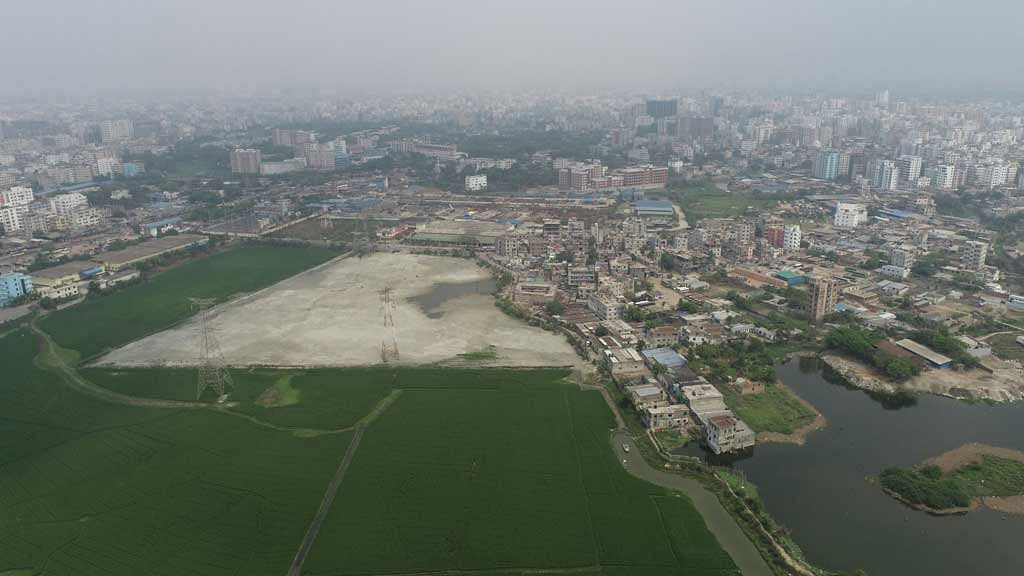Home
+
The capital’s environment becomes a hot topic with the mercury hitting a 58-year high of 40.5 degrees Celsius

Published : 17 Apr 2023, 03:04 AM
An ideal city requires surface water in at least 15 percent of its area, according to experts. But overcrowded Dhaka had bodies of water in only 4.38 percent of its area four years ago, a study showed. The share of surface water in the Bangladesh capital has fallen further, the surveyors say as they are conducting new research.
The city’s environment has become a hot topic with the mercury hitting a 58-year high of 40.5 degrees Celsius on Sunday. The average temperature of the country in April this year is 7-9 degrees Celsius above the usual level.
Golap Mia, a rickshawpuller residing in Korail, said he was out of home until 3am to cool him off before going to sleep amid the “tormenting” heat.
“There weren’t so many cars in Dhaka when I came here 30 years ago. The Banani area had many trees. The lake was bigger. It wasn’t so hot,” he recalled.

“Trees and surface water raise the level of humidity during hot weather, making it tolerable for humans and animals, no matter how hot it is. Residents do not suffer in some cities with hotter weather than ours because they have more bodies of water and trees,” said Mohan Kumar Das, executive director of National Oceanographic and Maritime Institute.
A study by Bangladesh Institute of Planners or BIP in 1999 showed that Dhaka had 19,09 square kilometres of water bodies, or 14.25 percent of the total area.
In 2000, the government passed the Natural Water Reservoir Conservation Act, which mandated keeping natural water bodies intact.
In 2009, the BIP conducted another study that showed Dhaka’s water bodies shrank to 7.68 square kilometres, or 5.73 percent of the total area.
One year later, the government amended the law, stipulating a maximum five-year jail term or Tk 50,000 fines for filling up pieces of land marked as water bodies.
According to the latest BIP study in 2019, the city had only 5.87 kilometres of water bodies, or 4.38 percent of its total area.
It means Dhaka lost 13.22 square kilometres or 70 percent of its surface water in two decades.
The BIP says their ongoing study shows further shrinking of space for water in the city.
The BIP studies showed Dhaka’s open space shrank to 4.28 square kilometres from 18.85 square kilometres in 1999.
Areas with greenery in Dhaka, however, rose to 12.45 square kilometres in 2009 from 8.97 square kilometres in 1999, before falling again to 12.33 square kilometres in 2019.
Areas with concrete structures in Dhaka increased to 109.63 square kilometres, or 81.82 percent of the total area in 2019, from 87.09 square kilometres or 64 percent of the total area in 1999.
‘NO PREVENTIVE STEPS’
Adil Mohammed Khan, president of BIP, said Aminbazar and Ashulia areas on the outskirts of the city were affected the most by filling of water bodies.
“There are no significant government steps against encroachment and land-filling – no efforts by the district administration, Department of Environment, RAJUK or police. How does a city survive like this?”

Some government agencies have instead filled water bodies to construct buildings.
At Gabtoli, Bangladesh Agricultural Development Corporation has started implementing a plan to build a research facility allegedly by blocking a natural drainage system.
Drainage water from different areas ends up on the land known as Kallyanpur Regulation Pond before reaching the Turag River, according to Dhaka North City Corporation, which asked the BADC to stop the construction of the building there.

To construct an elevated express, the authorities have filled up the water bodies from Banani to the airport, especially along the railway tracks.
Water bodies were also filled up while constructing Kuril flyover.
A site office for Purbachal New Town has been built by filling up a low-lying land near Kuril Bishwa Road.

Uttara Sector 18, police officers’ housing in Khilkhet, Ashiyan City, Bashundhara Residential Area and the 300 Feet Road were also once water bodies.
“Government agencies and private organisations own the water bodies and low-lying lands. They are filling these lands up. The city corporation is fighting a legal battle to stop it,” said Dhaka North Mayor Atiqul Islam.

Dhaka North City Corporation, however, is itself accused of felling trees for infrastructural development.
Its mayor sought to reassure the citizens by saying trees "will be planted in these places again”.